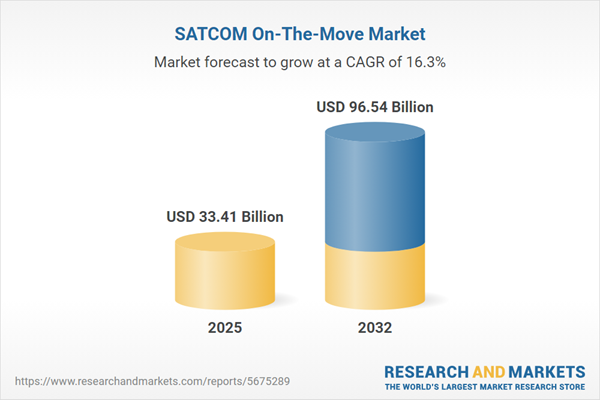Speak directly to the analyst to clarify any post sales queries you may have.
SATCOM On-The-Move solutions deliver essential, dependable mobile satellite connectivity for organizations operating in challenging or infrastructure-limited environments. Senior decision-makers leverage these technologies to maintain seamless communications, ensuring operational agility, resilience, and uninterrupted decision-making capabilities wherever terrestrial networks cannot be relied upon.
Market Snapshot: SATCOM On-The-Move Market Size and Growth
The SATCOM On-The-Move market is projected to increase from USD 28.75 billion in 2024 to USD 33.41 billion in 2025, reflecting a compound annual growth rate of 16.34%. By 2032, market size is expected to reach USD 96.54 billion. The demand for secure, real-time satellite communications has grown considerably as mobile enterprises consistently require connectivity beyond terrestrial reach. Industrial sectors including defense, logistics, maritime, and energy are integrating these advanced solutions to support continuous operations and informed decision-making in areas where conventional coverage is unavailable.
Scope & Segmentation of the SATCOM On-The-Move Market
- Platform Types: Airborne connectivity solutions provide reliable, secure communications for both manned and unmanned aircraft, enhancing coordination and monitoring. Land-based SATCOM supports uninterrupted fleet and rail operations throughout remote regions. Maritime platforms facilitate communications for commercial shipping, offshore energy, and naval operations in open waters, where ground-based infrastructure is not viable.
- End Users: Private-sector organizations are optimizing supply chain oversight and risk management. Public agencies utilize these systems to ensure compliance and maintain service consistency. Emergency services depend on robust connectivity for quick and effective crisis response. Maritime and energy stakeholders rely on persistent communication to support regulatory requirements, safety, and asset monitoring in dispersed or isolated areas.
- Frequency Bands: C Band is suitable for extended coverage and network reach. Ku and Ka Bands are optimized for high-capacity data transfers and dedicated multimedia needs. X Band caters primarily to defense and government entities that require resilient, tactical communications under critical conditions.
- Applications: Encrypted voice, secure high-speed data transfer, live video streaming for situational awareness, on-site broadcasting, tactical navigation, and continuous surveillance during extended field operations are covered under the main use cases.
- Geographic Coverage: Adoption is accelerating across the Americas, EMEA, and Asia-Pacific, with deployments tailored by region to align with local infrastructure, regulatory standards, and strategic connectivity priorities.
- Companies Profiled: Leading innovators shaping the SATCOM On-The-Move landscape include EchoStar Corporation, Viasat, Cobham SATCOM AS, Intellian Technologies, Kymeta, Gilat Satellite Networks, KVH Industries, Thales, Leonardo, and L3Harris Technologies, each advancing the sector through ongoing technological improvements and market-driven benchmarks.
Key Takeaways for Decision-Makers
- Digital beamforming and software-defined payloads allow rapid adaptation of communications infrastructure, ensuring operational alignment as objectives evolve.
- Blending terrestrial and satellite systems with 5G and edge computing enables continuous, high-capacity connections and efficient support for large-scale activities.
- Modular terminal designs offer flexibility for quick scaling and streamlined upgrades when expanding fleet capacity or adapting to changing network demands.
- Implementation of advanced encryption and active interference management secures sensitive communications, supporting dependable operations in dynamic or higher-risk scenarios.
- Open standards and multi-band technologies facilitate future upgrades and integration, minimizing disruption and maintaining infrastructure relevance.
Tariff Impact & Supply Chain Realignment
Recent U.S. tariff adjustments affecting SATCOM On-The-Move components are prompting integrators and buyers to diversify their supplier base and select modular equipment. This approach promotes procurement flexibility and sustains operational continuity amid evolving regulations or supply interruptions. Organizations are prioritizing interoperability and robust supply chain structures to protect project timelines and manage financial exposure as market requirements shift.
Methodology & Data Sources
This market assessment draws on secondary research, direct interviews with satellite operators, regulators, manufacturers, and end users. Comprehensive validation through financial and procurement data ensures reported findings are consistent with prevailing industry standards and practices.
SATCOM On-The-Move Market: Why This Report Matters
- Supports executive and management teams with insight to invest confidently in mobile connectivity solutions that promote adaptability and resilience in rapidly shifting environments.
- Provides strategic analysis for optimizing procurement processes, compliance efforts, and technical implementation to sustain competitiveness.
- Delivers timely intelligence to help leaders recognize and address industry changes as they navigate evolving communication requirements.
Conclusion
SATCOM On-The-Move solutions empower organizations to maintain reliable communications and respond decisively to challenges, ensuring continuity and adaptability as satellite technologies develop and connect critical operations in demanding environments.
Additional Product Information:
- Purchase of this report includes 1 year online access with quarterly updates.
- This report can be updated on request. Please contact our Customer Experience team using the Ask a Question widget on our website.
Table of Contents
3. Executive Summary
4. Market Overview
7. Cumulative Impact of Artificial Intelligence 2025
Companies Mentioned
The companies profiled in this SATCOM On-The-Move market report include:- EchoStar Corporation
- Viasat, Inc.
- Cobham SATCOM AS
- Intellian Technologies Co., Ltd.
- Kymeta Corporation
- Gilat Satellite Networks Ltd.
- KVH Industries, Inc.
- Thales S.A.
- Leonardo S.p.a.
- L3Harris Technologies, Inc.
Table Information
| Report Attribute | Details |
|---|---|
| No. of Pages | 194 |
| Published | November 2025 |
| Forecast Period | 2025 - 2032 |
| Estimated Market Value ( USD | $ 33.41 Billion |
| Forecasted Market Value ( USD | $ 96.54 Billion |
| Compound Annual Growth Rate | 16.3% |
| Regions Covered | Global |
| No. of Companies Mentioned | 11 |









